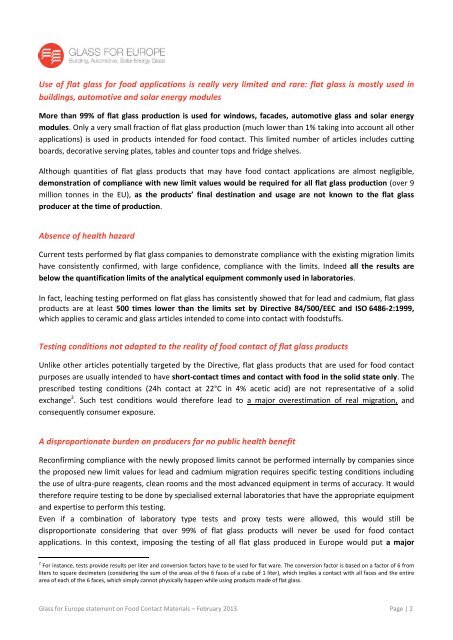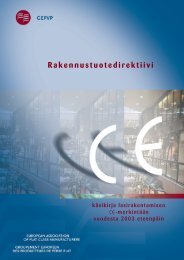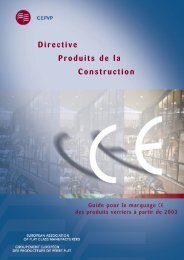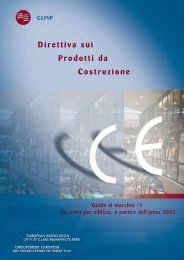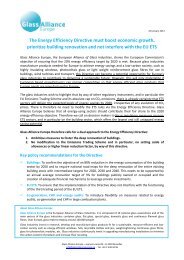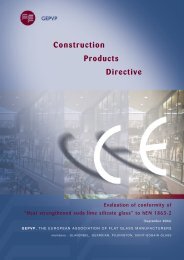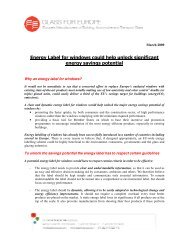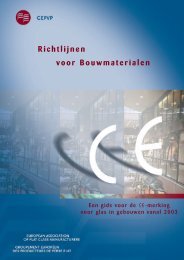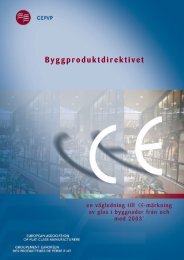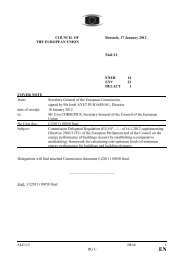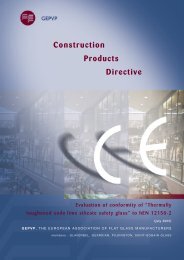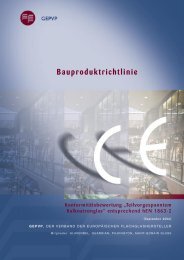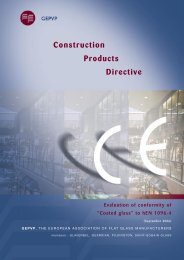glass for europe statement on food contact materials
glass for europe statement on food contact materials
glass for europe statement on food contact materials
You also want an ePaper? Increase the reach of your titles
YUMPU automatically turns print PDFs into web optimized ePapers that Google loves.
Use of flat <str<strong>on</strong>g>glass</str<strong>on</strong>g> <str<strong>on</strong>g>for</str<strong>on</strong>g> <strong>food</strong> applicati<strong>on</strong>s is really very limited and rare: flat <str<strong>on</strong>g>glass</str<strong>on</strong>g> is mostly used in<br />
buildings, automotive and solar energy modules<br />
More than 99% of flat <str<strong>on</strong>g>glass</str<strong>on</strong>g> producti<strong>on</strong> is used <str<strong>on</strong>g>for</str<strong>on</strong>g> windows, facades, automotive <str<strong>on</strong>g>glass</str<strong>on</strong>g> and solar energy<br />
modules. Only a very small fracti<strong>on</strong> of flat <str<strong>on</strong>g>glass</str<strong>on</strong>g> producti<strong>on</strong> (much lower than 1% taking into account all other<br />
applicati<strong>on</strong>s) is used in products intended <str<strong>on</strong>g>for</str<strong>on</strong>g> <strong>food</strong> c<strong>on</strong>tact. This limited number of articles includes cutting<br />
boards, decorative serving plates, tables and counter tops and fridge shelves.<br />
Although quantities of flat <str<strong>on</strong>g>glass</str<strong>on</strong>g> products that may have <strong>food</strong> c<strong>on</strong>tact applicati<strong>on</strong>s are almost negligible,<br />
dem<strong>on</strong>strati<strong>on</strong> of compliance with new limit values would be required <str<strong>on</strong>g>for</str<strong>on</strong>g> all flat <str<strong>on</strong>g>glass</str<strong>on</strong>g> producti<strong>on</strong> (over 9<br />
milli<strong>on</strong> t<strong>on</strong>nes in the EU), as the products’ final destinati<strong>on</strong> and usage are not known to the flat <str<strong>on</strong>g>glass</str<strong>on</strong>g><br />
producer at the time of producti<strong>on</strong>.<br />
Absence of health hazard<br />
Current tests per<str<strong>on</strong>g>for</str<strong>on</strong>g>med by flat <str<strong>on</strong>g>glass</str<strong>on</strong>g> companies to dem<strong>on</strong>strate compliance with the existing migrati<strong>on</strong> limits<br />
have c<strong>on</strong>sistently c<strong>on</strong>firmed, with large c<strong>on</strong>fidence, compliance with the limits. Indeed all the results are<br />
below the quantificati<strong>on</strong> limits of the analytical equipment comm<strong>on</strong>ly used in laboratories.<br />
In fact, leaching testing per<str<strong>on</strong>g>for</str<strong>on</strong>g>med <strong>on</strong> flat <str<strong>on</strong>g>glass</str<strong>on</strong>g> has c<strong>on</strong>sistently showed that <str<strong>on</strong>g>for</str<strong>on</strong>g> lead and cadmium, flat <str<strong>on</strong>g>glass</str<strong>on</strong>g><br />
products are at least 500 times lower than the limits set by Directive 84/500/EEC and ISO 6486-2:1999,<br />
which applies to ceramic and <str<strong>on</strong>g>glass</str<strong>on</strong>g> articles intended to come into c<strong>on</strong>tact with <strong>food</strong>stuffs.<br />
Testing c<strong>on</strong>diti<strong>on</strong>s not adapted to the reality of <strong>food</strong> c<strong>on</strong>tact of flat <str<strong>on</strong>g>glass</str<strong>on</strong>g> products<br />
Unlike other articles potentially targeted by the Directive, flat <str<strong>on</strong>g>glass</str<strong>on</strong>g> products that are used <str<strong>on</strong>g>for</str<strong>on</strong>g> <strong>food</strong> c<strong>on</strong>tact<br />
purposes are usually intended to have short-c<strong>on</strong>tact times and c<strong>on</strong>tact with <strong>food</strong> in the solid state <strong>on</strong>ly. The<br />
prescribed testing c<strong>on</strong>diti<strong>on</strong>s (24h c<strong>on</strong>tact at 22°C in 4% acetic acid) are not representative of a solid<br />
exchange 2 . Such test c<strong>on</strong>diti<strong>on</strong>s would there<str<strong>on</strong>g>for</str<strong>on</strong>g>e lead to a major overestimati<strong>on</strong> of real migrati<strong>on</strong>, and<br />
c<strong>on</strong>sequently c<strong>on</strong>sumer exposure.<br />
A disproporti<strong>on</strong>ate burden <strong>on</strong> producers <str<strong>on</strong>g>for</str<strong>on</strong>g> no public health benefit<br />
Rec<strong>on</strong>firming compliance with the newly proposed limits cannot be per<str<strong>on</strong>g>for</str<strong>on</strong>g>med internally by companies since<br />
the proposed new limit values <str<strong>on</strong>g>for</str<strong>on</strong>g> lead and cadmium migrati<strong>on</strong> requires specific testing c<strong>on</strong>diti<strong>on</strong>s including<br />
the use of ultra-pure reagents, clean rooms and the most advanced equipment in terms of accuracy. It would<br />
there<str<strong>on</strong>g>for</str<strong>on</strong>g>e require testing to be d<strong>on</strong>e by specialised external laboratories that have the appropriate equipment<br />
and expertise to per<str<strong>on</strong>g>for</str<strong>on</strong>g>m this testing.<br />
Even if a combinati<strong>on</strong> of laboratory type tests and proxy tests were allowed, this would still be<br />
disproporti<strong>on</strong>ate c<strong>on</strong>sidering that over 99% of flat <str<strong>on</strong>g>glass</str<strong>on</strong>g> products will never be used <str<strong>on</strong>g>for</str<strong>on</strong>g> <strong>food</strong> c<strong>on</strong>tact<br />
applicati<strong>on</strong>s. In this c<strong>on</strong>text, imposing the testing of all flat <str<strong>on</strong>g>glass</str<strong>on</strong>g> produced in Europe would put a major<br />
2 For instance, tests provide results per liter and c<strong>on</strong>versi<strong>on</strong> factors have to be used <str<strong>on</strong>g>for</str<strong>on</strong>g> flat ware. The c<strong>on</strong>versi<strong>on</strong> factor is based <strong>on</strong> a factor of 6 from<br />
liters to square decimeters (c<strong>on</strong>sidering the sum of the areas of the 6 faces of a cube of 1 liter), which implies a c<strong>on</strong>tact with all faces and the entire<br />
area of each of the 6 faces, which simply cannot physically happen while using products made of flat <str<strong>on</strong>g>glass</str<strong>on</strong>g>.<br />
Glass <str<strong>on</strong>g>for</str<strong>on</strong>g> Europe <str<strong>on</strong>g>statement</str<strong>on</strong>g> <strong>on</strong> Food C<strong>on</strong>tact Materials – February 2013 Page | 2


